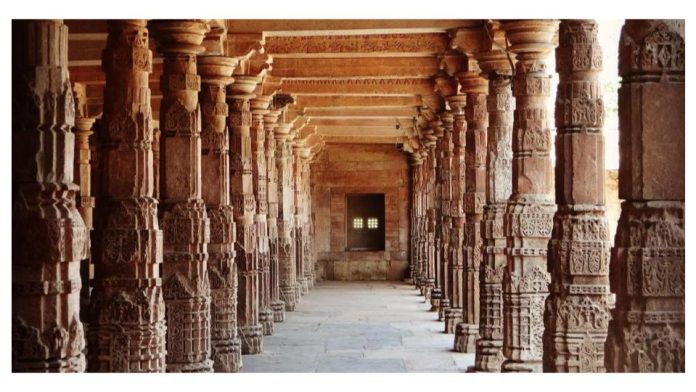The Archaeological Survey of India (ASI) team is conducting a survey of the Bhojshala located in Dhar, Madhya Pradesh, as per the orders of the Madhya Pradesh High Court. The ASI team will determine whether the Bhojshala houses the Saraswati Temple or the Kamal Maulana Mosque based on archaeological and scientific surveys. Stringent security arrangements have been made around the premises of the Bhojshala. The court had directed the ASI on March 11 to conduct a scientific survey of the controversial Bhojshala within six weeks. Let’s find out the history of the Bhojshala in Dhar and why the fresh controversy has arisen. And to comply with that the ASI started the survey on March 22.
Backdrop of the case
Bhojshala is a protected monument from the 11th century, considered by Hindus as the temple of Vagdevi (Goddess Saraswati) and by Muslims as Kamal Maulana Mosque. While the controversy surrounding the Bhojshala is decades old, it took a new turn in 2022 when a petition was filed in the Indore High Court. The petition demanded the installation of the idol of Goddess Saraswati and the documentation of the entire premises through photography and videography. The petition also sought to halt prayers at the site.
On March 11, the court ordered the ASI to conduct a scientific survey of the premises. The Muslim side had knocked on the Supreme Court’s door to intervene in the matter. However, the Supreme Court refused to interfere with the High Court’s order on the Muslim side’s petition. The Supreme Court stated that it would not issue any orders in this matter at the moment. The Muslim side was demanding an immediate halt to the survey.
History of Bhojshala complex
Thousands of years ago, this place was ruled by the Paramara dynasty. From 1000 to 1055 CE, King Bhoj ruled here. He was a devoted follower of Goddess Saraswati. In 1034 CE, he established a university which later came to be known as ‘Bhojshala’ named after him. It is said that Alauddin Khilji destroyed the Bhojshala in 1305 CE. Then, in 1401 CE, Dilawar Khan Gauri built a mosque in one part of it. Mahmud Shah Khilji built another mosque in the other part in 1514 CE.
Almost 350 years later, the excavation was carried out here in 1875 and the statue of Goddess Saraswati was unearthed, which was taken by Major Kincaid to London. Currently, the statue is in a museum in London.
Currently, Hindu organizations consider it to be the temple of Raja Bhoj’s era. Their argument is that during the reign of the dynasty, Muslims were allowed to offer prayers for some time. On the other hand, the Muslim side claims that they have been offering prayers here for many years. They refer to this place as Bhojshala-Kamal Maulana Mosque.
Current controversy around Bhojshala
The controversy surrounding the Bhojshala is many years old, which has caused tension between Hindu and Muslim factions multiple times. With the advent of Basant Panchami the conflict escalates between Hindus and Muslims. Considerably, Basant Panchami is the only annual festival for worshiping Ma Sarswati. Hindus are allowed entry into the Bhojshala from sunrise to sunset for worship on Tuesdays. Additionally, on Fridays, from 1 p.m. to 3 p.m., only those offering Namaz are permitted to enter. The rest of the week, the Bhojshala remains open for all visitors from sunrise to sunset, with an entry fee of one rupee.
It is important to understand when pooja and namaz were permitted here simultaneously. In 1909, the princely state of Dhar declared the Bhojshala a protected monument. Later, it was handed over to the Archaeological Department. In 1935, the princely state of Dhar allowed prayers here on Fridays. Earlier, the premises used to be open only on Fridays. In 1995, a dispute arose here, after which worship on Tuesdays and prayers on Fridays were allowed.
Two years later, on May 12, 1997, the Collector banned the entry of the general public into the Bhojshala and also halted pooja on Tuesdays. Only namaz on Fridays and worship on Basant Panchami were allowed. However, the ban was lifted just two months later. But, on February 6, 1998, the Archaeological Department again imposed a ban on entry here and halted pooja on Tuesdays. In 2003, all restrictions were finally lifted, and entry for tourists along with worship was allowed.
Everything was going smoothly until 2013 when Basant Panchami was celebrated on Friday, which caused a disruption in the area. Police had to resort to lathi-charge to control the situation. Again in 2016, a similar situation arose when Basant Panchami was celebrated on Friday, leading to unrest.
Reclamation for getting free from colonial captivity
This must be noted that numerous Hindu temples and holy sites have been desecrated and vandalised by barbaric Islamic invaders in history. While the ancient Indian society showed utmost tolerance and assimilation character, they suffered as the cost of it. As a result the reclamation of the holy site is imperative to their awakening of cultural and religious conscience. The consecration of Ram Mandir in Ayodhya marks a milestone in that direction. In a way, the reclamation of site as the only viable option to get their religious rights and get their temples free from colonial captivity.

